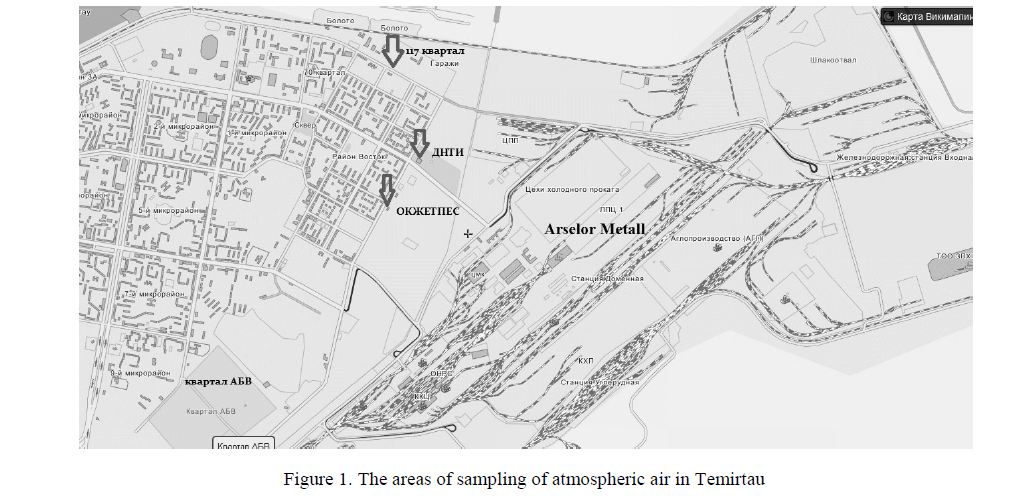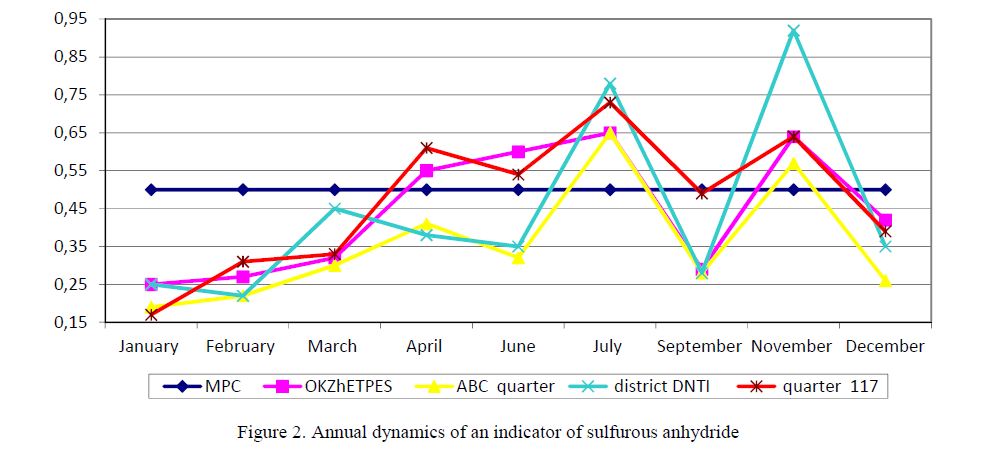In this article influence of the Arselor Metall Steel enterprise on the condition of atmospheric air of districts of the city of Temirtau, adjacent to the enterprise, is considered. The annual dynamics of the content of harmful substances in the air reflecting the main tendency of increase of the indicators values in summer months, mainly in July, decrease in September and repeated increase of values in November are shown. The main substances polluting the air were defined: dust, nitrogen oxides, sulfurous anhydride, phenol, ammonia, carbon monoxide, hydrogen sulfide. The analysis of the results showed that in the surface layer of the atmosphere of the studied areas the concentration of sulfurous anhydride and hydrogen sulfide considerably exceeds the standard values. According to the results of the research it was revealed that the region OKZhETPES, the area DNTI and 117 quarter belong to the zones, which are exposed to the most intensive negative impact, the quarter ABC belongs to the zone with the least pollution.
Air is the basis of our life. Clean air, is that basic, vital component, which must be taken into account in everyday life of a person. On its quality depends not only health of a person, but also condition of soil cover, water environment, flora and fauna in general. Fresh air is absolutely necessary for life of all living things on our planet [1].
Fixing and assessment of changes of condition of atmospheric air give a reliable picture and reflect the state of the environment.
Heavy metals are often called the most dangerous pollutants of the environment as they are highly toxic, can move with water and air streams, are capable to collect in soils, ground deposits of reservoirs. Excess of heavy metals in soil leads to their accumulation by plants and, consequently, to their excessive consumption by a person [2].
In recent years the economy of the Karaganda region is developing dynamically. But unfortunately, the industrial complex of the region, except important social and economic value, has also serious negative ecological consequences. The most ecologically unsuccessful cities are Temirtau and Balkhash, which share of the emissions of the area is more than 60 %. In Temirtau 90 % of emissions is the share of Steel department JSC «Arselormittal Temirtau,» which is the largest production object in the region [3].
In Temirtau, where the large steel mill is situated, high level of air pollution by several contaminants, including high hazard class, is noted.
The share of ferrous metallurgy accounts for about 50 % of the total harmful emissions into the atmosphere and soil.
Materials and methods of research
In the course of investigations, tests of atmospheric air of residential areas of Temirtau city during 2014 were selected.
When studying dynamics of pollution of atmospheric air of the city of Temirtau sampling was made on 4 posts: in the area OKZHETPES, the area DNTI, the quarter of ABC, the quarter 117 (Fig. 1), located in the zone of influence of the industrial platform of JSC «Arselormitall Temirtau», to define the main polluting substances: raise dust, nitrogen oxides, sulfurous anhydride, phenol, ammonia, carbon monoxide, hydrogen sulfide.
Route positions were chosen in accordance with RD 52.04.186–89 «Guidelines for the control of air pollution». Measurements were performed using a portable gas analyser GANK-4. In total 1460 samplings of atmospheric air were made. On each point not less than 3 instrument readings in an equal period of time were taken (indications were averaged). Tests of air were selected at the time of its greatest pollution from the downwind side of the pollution source. The duration of sampling was 15–20 minutes, at 0,5–2 meters from the ground.

Figure 1. The areas of sampling of atmospheric air in Temirtau
JSC «ArcelorMittal Temirtau» is an enterprise with full metallurgical cycle, which also includes electric power stations: CHP (heat power station) -PVS and CHP-2. The main production objects are: production of agglomerate, coke-chemical production, blast furnace, converter and sheet-rolling shops.
In the process of agglomerate production to the atmosphere comes dust, carbon oxide, nitrogen oxides and sulfur dioxide [4, 5].
Technological process of steel-smelting production is followed by release of dust, carbon monoxide, oxides of nitrogen and sulfurous anhydride.
In blast furnaces production hydrogen sulfide and nitrogen oxides are emitted in addition, in rolling production aerosols of etching solutions, couples of emulsions and nitrogen oxides are also emitted. The greatest number of emissions is in coke-chemical production. Here except the listed pollutants it is possible to note the pyridine bases, aromatic hydrocarbons, phenols, ammonia, 3–4-benzopyrene, hydrogen cyanide, and others [6].
Figure 2 shows the data of the dynamics of atmospheric air condition in 2014 on the level of sulfur dioxide pollution in the area of OKZHETPES, district DNTI, ABC quarter, quarter 117.

Figure 2. Annual dynamics of an indicator of sulfurous anhydride
Annual dynamics shows the growth of the indicator values from winter months to the summer period in all investigated parts of the city. In September decrease of an indicator to the level of maximum permissible concentration (MPC) is marked, that can testify to influence of atmospheric waters on air clarification, due to increase in precipitation [7]. Significant increase in amount of sulfurous anhydride in November in all studied areas can testify to increase in work of heat power stations in connection with a heating season. The main emissions in the atmosphere from combined heat and power plant are dust (ashes), sulfurous anhydride, nitrogen oxides.
The excess of maximum permissible concentration is noted during the period from April to July in the area of OKZhETPES and in the 117 quarter, the maximum values are noted in July and in November in all studied areas, and the maximum concentration is noted in the area of DNTI and makes 0,92 mg/m3, while maximum permissible concentration makes 0,5 mg/m3. The southwest direction of wind, at which there is an imposing of torches of emissions from CHPP-PVS and the power electric station located on the territory of the enterprise, can influence high concentrations in this area, it strengthens air pollution. Also from the received results it is possible to note that areas, subjected to the maximum pollution, taking into account values of an indicator of sulfurous anhydride, are DNTI and the quarter 117. Quarter ABC belongs to the area with the smallest level of sulfurous anhydride within a year, excess of maximum permissible concentration is noted in July and November and makes 0,65 mg/m3 and 0,57 mg/m3 accordingly.
Sulfurous anhydride is dangerous at inhalation. Even very small concentration of it creates unpleasant taste in a mouth and irritates mucous membranes. Vapors of sulfurous anhydride in damp air strongly irritate mucous membranes and skin. Adverse effect of sulfur dioxide may be aggravated by influence in combination with other substances, for example, carbon monoxide and oxides of nitrogen [8].
The level of air pollution with ammonia of areas adjacent to the territory of the plant can be seen in Figure 3.

Figure 3. Annual dynamics of the level of ammonia indicator
Considering dynamics of values of the ammonia indicator in the air of the city of Temirtau within a year we observe a similar picture of change of level of pollution by sulfurous anhydride: the growth of the indicator from winter months to summer, decrease in September and increase of values in November, except for the region of DNTI where the value of ammonia in September exceeds MPC and makes 0,27 mg/m3. The maximum excess of MPC is noted in June in regions of DNTI and OKZhETPES and makes 0,33 mg/m3 and 0,28 mg/m3 accordingly, despite the fact that the wind has the northwest direction. In the quarter 117 the maximum concentration is recorded in July and makes 0,27 mg/m3, in November it corresponds to value of 0,25 mg/m3 at the southwest direction of the wind, which promotes increase in concentration of substance. The smallest concentration of substance is observed in February in all studied areas. The quarter ABC can be considered the favorable area in relation to the level of air pollution by ammonia, in this area the excess of maximum permissible concentration is observed only in June and corresponds to value of 0,22 mg/m3, with MPC equal to 0,2 mg/m3.
In Figure 4 dynamics of the level of air pollution by hydrogen sulfide in the studied districts of Temirtau is presented.

Figure 4. The annual dynamics of the level of the hydrogen sulfide indicator
In metallurgy hydrogen sulfide is emitted in the coke-chemical production, in the process of loading coal charge, delivery and suppression of coke. Also during the work of installations of granulation of slag and production of cast crushed stone steam-gas mix is formed, which part is carbon oxide, hydrogen sulfide, sulfur dioxide.
Annual dynamics of hydrogen sulfide indicator correspond to the above provided charts of indicators of sulfurous anhydride and ammonia, the increase of the indicator in June and July, the decrease in September and repeated increase in November is observed. In figure 4 it is possible to see that in all studied areas the amount of hydrogen sulfide exceeds maximum permissible concentration in June and July, though the wind has the northwest direction. In November the content of ammonia is high in three studied areas, only in the area DNTI there isn't any excess of maximum permissible concentration. In March and April indicators of the content of substance are on border of the MPC level, equal to 0,008 mg/m3. The maximum values of an indicator can be noted in the area of Okzhetpes and DNTI — 0,019 mg/m3.
The analysis of other four studied components showed that the increase of indicators happens in April and the maximum values are noted during the summer period, so in April the content of dust in OKZhETPES area is equal to 0,34 mg/m3, in June it makes 0,35 mg/m3, in the ABC quarter it corresponds to value of 0,29 mg/m3 and 0,31 mg/m3 accordingly, when MPC is equal to 0,3 mg/m3. The nitrogen dioxide indicator in June in OKZhETPES area is equal to 0,091 mg/m3, in November it is 0,089, when MPC is 0,085 mg/m3. Phenol exceeds the value of MPC only in April in the quarter 117 and makes 0,012 mg/m3, the direction of the wind is southwest, and that increases concentration of substance, as streams of the polluted air at such direction go from the enterprise territory towards the city. During all other period the indicator is in the limits which don't exceed the MPC. Carbon oxide within a year in all studied areas doesn't exceed the value of the maximum permissible concentration equal to 5 mg/m3.
Thus, researches showed that the greatest air pollution is noted during the summer period and repeated increase in indicators takes place in November. It may be caused by various reasons (adverse weather conditions, growth of volume of an industrial output during summer period, etc.), which demand further more careful analysis, and carrying out additional research works. It is possible to come to the conclusion that the quarter ABC belongs to the zone with the smallest pollution.
In the level of emissions of harmful substances into the atmosphere and reservoirs, formation of solid wastes metallurgy surpasses all raw industries, leading to strong environmental pollution in areas, where the metallurgical enterprises work. Iron and steel works are the largest pollutants of atmospheric air in the areas of their location.
References
- Gribbin J. A History (1543–2001), L.: Penguin Books, 2003, 648 p.
- The main anthropogenic pollutants and methods of their control, E-online library, http://banauka.ru/5695.html
- JSC «ArcelorMittal Temirtau», http://www.arcelormittal.kz/index.php? id=339
- Fedyaeva A. Industrial Ecology. Lecture notes, Omsk: Publishing House of the Omsk State Technical University, 2007, 145 p.
- Production of agglomerate, http://www.stroitelstvo-new.ru/gigiena-truda/proizvodstvo-aglomerata.shtml
- Bolshina E.P. Ecology of metallurgical production. Lecture course, Novotroitsk, 2012.
- Alekseev V.V., Zaitsev S.I., Kokorin A.O. Meteorology and Hydrology, 1988, 10, p. 66–71.
- Orlov S., Sadovnikov L.K., Lozanovskii I.N. Ecology and protection of the biosphere at chemical pollution: Textbook, Moscow: Vysshaya shkola, 2002, 334 p.